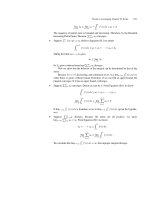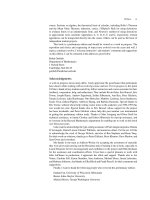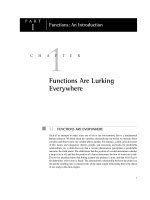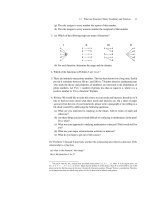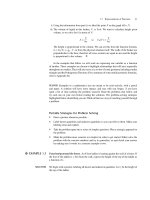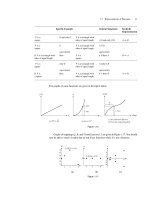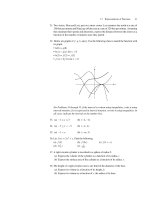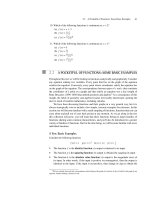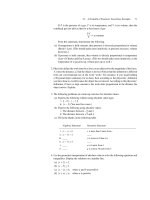Calculus: An Integrated Approach to Functions and their Rates of Change, Preliminary Edition Part 1 pps
Bạn đang xem bản rút gọn của tài liệu. Xem và tải ngay bản đầy đủ của tài liệu tại đây (120.48 KB, 10 trang )
Calculus
An Integrated Approach to Functions and Their Rates of Change
PRELIMINARY EDITION
Calculus
An Integrated Approach to Functions and Their Rates of Change
PRELIMINARY EDITION
ROBIN J. GOTTLIEB
HARVARD UNIVERSITY
Sponsoring Editor: Laurie Rosatone
Managing Editor: Karen Guardino
Project Editor: Ellen Keohane
Marketing Manager: Michael Boezi
Manufacturing Buyer: Evelyn Beaton
Associate Production Supervisor: Julie LaChance
Cover Design: Night and Day Design
Cover Art: The Japanese Bridge by Claude Monet; Suzuki Collection, Tokyo/Superstock
Interior Design: Sandra Rigney
Senior Designer: Barbara Atkinson
Composition: Windfall Software
Library of Congress Cataloging-in-Publication Data
Gottlieb, Robin (Robin Joan)
Calculus: an integrated approach to functions and their rates of change / by Robin
Gottlieb.—Preliminary ed.
p. cm.
ISBN 0-201-70929-5 (alk. paper)
1. Calculus. I. Title.
QA303 .G685 2001 00-061855
515—dc21
Copyright © 2002 by Addison-Wesley
Reprinted with corrections.
All rights reserved. No part of this publication may be reproduced, stored in a retrieval
system, or transmitted, in any form or by any means, electronic, mechanical, photocopying,
recording, or otherwise, without the prior written permission of the publisher.
Printed in the United States of America.
2345678910—CRS—04 03 02 01
To my family,
especially my grandmother,
Sonia Gottlieb.
Preface
The concepts of calculus are intriguing and powerful. Yet for a learner not fluent in the
language of functions and their graphs, the learner arriving at the study of calculus poorly
equipped, calculus may become a daunting hurdle rather than a fascinating exploration.
The impetus to develop a course integrating calculus with material traditionally labeled
“precalculus” emerged from years of working with a sequential college system.
Few students regard the prospect of taking a precalculus course as inspiring. In the eyes
of many students it lacks the glamour and prestige of calculus. For some students, taking
precalculus means retaking material “forgotten” from high school, and, bringing the same
learning skills to the subject matter, such a student may easily “forget” again. At many
colleges, students who successfully complete a precalculus course subsequently enroll in a
calculus course that compresses into one semester what their better prepared fellow students
have studied back in high school over the course of a full year. Yet any lack of success in
such a course is bemoaned by teachers and students alike.
The idea behind an integrated course is to give ample time to the concepts of calculus,
while also developing the students’ notion of a function, increasing the students’ facility
in working with different types of functions, facilitating the accumulation of a robust
set of problem-solving skills, and strengthening the students as learners of mathematics
and science. An integrated course offers freedom, new possibilities, and an invigorating
freshness of outlook. Freshness in particular is valuable for the student who has taken some
precalculus (or even calculus) but come away without an understanding of its conceptual
underpinnings.
This text grew out of an integrated calculus and precalculus course. Three general
principles informed the creation of both the course and the text.
Developing mathematical reasoning and problem-solving skills must not be made
subservient to developing the subject matter.
Making connections between mathematical ideas and representations and making con-
nections between functions and the world around us are important to fostering a con-
ceptual framework that will be both sturdy and portable.
Generating intellectual excitement and a sense of the usefulness of the subject matter is
important for both the students’ short-term investment in learning and their long-term
benefits.
vii
viii Preface
Developing Mathematical Reasoning
Mathematical reasoning skills are developed by learning to make conjectures and convinc-
ing mathematical arguments. Mathematics, like any other language, must be spoken before
being spoken well. Students initially need to learn to make mathematical arguments at their
own level, whatever that level may be. The instructor can model logically convincing ar-
guments, but if students are not given the opportunity to engage in discussion themselves,
they are not likely to acquire discussion skills.
The structure of this text is intended to facilitate learning deductive and inductive
reasoning, learning to use examples and counterexamples, and learning to understand the
usefulness of a variety of perspectives in devising an argument. Students are encouraged to
seek patterns and connections, to make conjectures and construct hypotheses. The reflective
thinking this fosters helps students develop judgment and confidence.
Making Connections
Ideas are presented and discussed graphically, analytically, and numerically, as well as in
words, with an emphasis throughout on the connections between different representations.
There is an emphasis on visual representations. Topics are introduced through examples and,
often, via applications and modeling, in order to build connections between mathematics,
the students’ experience outside mathematics, and problems in other disciplines, such as
economics, biology, and physics.
Generating Enthusiasm
When the storylines of mathematics get buried under technicalities and carefully polished
definitions, both those storylines and the enthusiasm new learners often bring to their studies
may well be lost. When all the technical details and theory are laid out in full at the start,
students may become lost and, not understanding the subtleties involved, simply suspend
judgment and substitute rote memorization. The intrepid learner has more potential than the
timid, self-doubting learner. For these reasons, answers to questions students are unready
to ask are often omitted. Definitions may be given informally before they are provided
formally; likewise, proofs may be given informally or not given in the body of the text but
placed in an appendix. In this text, the presentation is not always linear, not all knots are
tied immediately, and some loose ends are picked up later. The goal is to have students learn
material and to have them keep concepts solidly in their minds, as opposed to setting the
material out on paper in a neat and exhaustive form.
About the Problems
Problems are the heart of any mathematics text. They are the vehicles through which the
learner engages with the material. Certainly, they consume the bulk of students’ time and
energy. A lot of class time can be constructively spent discussing problems as well. To do
mathematics requires reflection, and discussion both encourages and enriches reflection.
The first 16 chapters offer “Exploratory Problems.” These are integral to the text, and
some are referred to in later sections. Exploratory problems can be incorporated into the
course in many ways, but the bottom line remains that they need to be worked and discussed
by students. Exploratory problems can be done as in-class group exercises, given as group
homework problems, or given as homework to be discussed by the class during the following
class meeting. Many of these problems combine or encourage different viewpoints and
require the student to move between representations. Some exploratory problems call for
Preface ix
conjectures that will subsequently be proven; some call for experimentation. The problems
attempt to exercise and stretch mathematical reasoning and the process of discussing them
is meant to constitute a common core experience of the class.
This preliminary edition includes many problems that require basic analytic manipula-
tion. In the sense that mathematics is a language, these problems are analogousto vocabulary
drills. They are exercises designed to support the less routine problems. But doing only these
warm-up exercises would mean missing the spirit of the text and circumventing the goals
laid out in this preface. Because problem solving involves determining which tools to use
in a given situation, sometimes a few problems at the end of a section may best be solved
by using tools from a previous section.
The text assumes that students have access to either a graphing calculator or a computer.
Technology may be incorporated to a greater or lesser extent depending upon the philosophy
and goals of the instructor.
Structuring the Content
The text covers the equivalent of a precalculus course plus one year of one-variable calculus.
Parts I through VII meld precalculus and first-semester calculus. A yearlong course might
cover Parts I through VIII and sections of Part IX, although the composition of the syllabus
is, of course, at the instructor’s discretion.
Part I provides an introduction to functions and their representations with an emphasis
on the relationship between meaning and symbolic and graphic representations. From the
outset the study of functions and the study of calculus are intertwined. For example, although
the first set of exploratory problems requires no particular mathematical knowledge, the
ensuing discussion inevitably involves the notion of relative rates of change. Similarly, in
extracting information about velocity from a graph of position versus time, or extracting
information about relative position from a graph of velocity versus time, students explore
the relationship between a function and its derivative without being formally introduced to
the derivative.
Part II focuses on rates of change and modeling using linear and quadratic functions.
Linearity and interpretation of slope precede the derivative and its interpretation. Knowing
about lines and the relationship between a function and its derivative provides a new window
into quadratics. A chapter devoted to quadratics allows students to work through issues of
sign and the relationship between a function and its graph as well as tackle optimization
problems both with and without using calculus.
Traditionally applied optimization problems appear in a course after all of the for-
mal symbolic derivative manipulations have been mastered. Taking on these problems
incrementally permits the topic to be revisited multiple times. The most difficult aspect
of optimization involves translating the problem into mathematics and expressing the quan-
tity to be optimized as a function of a single variable. Part I, Chapter 1 and Part II, Chapters
4 and 6 address these skills.
Once students are able to appreciate the usefulness of computing derivatives, the notions
of limits and continuity can be addressed more thoroughly in Chapter 7. Chapter 8 builds
on that basis, revisiting the idea of local linearity and introducing the Product and Quotient
Rules.
Part III introduces exponential functions through modeling. These functions are treated
early on, because students of biology, chemistry, and economics need facility in dealing with
them right away. The derivatives of exponentials are therefore discussed twice, first before
the discussion of logarithms and then, more completely, after it. This order leaves some
x Preface
loose ends, but the subsequent resolution after a few weeks is quite satisfying and makes
the natural logarithm seem natural. The number e is introduced as the base for which the
derivative of b
x
is b
x
. Part III also takes up polynomials and optimization.
Part IV deals more fully with logarithmic and exponential functions and their deriva-
tives. The number e is revisited here. By design, the Chain Rule is delayed until after the
differentiation of the exponential and logarithmic functions. Differentiating these functions
without the Chain Rule gives students a lot of practice with logarithmic and exponential ma-
nipulations. For instance, to differentiate ln(3x
7
) the student must rewrite the expression
as ln 3 + 7lnx .Chapter 15, which introduces differential equations via the exponential
function, can be postponed if the instructor prefers.
Part V revisits differentiation by addressing the Chain Rule and implicit differentiation.
Part VI provides an excursion into geometric sums and geometric series. A mobile
chapter, it can easily be postponed to immediately precede Part X, on series. If, however,
the class includes students of economics and biology who will not necessarily study Taylor
series, then the students will be well served by studying geometric series. Part VI emphasizes
modeling, using examples predominantly drawn from pharmacology and finance.
Part VII presents the trigonometric functions, inverse trigonometric functions, and
their derivatives. From a practical point of view, this order means that trigonometry is
pushed to the second semester. The rationale is twofold. First, some traditional precalculus
material must be delayed to make room for the bulk of differential calculus in the first
semester. Second, delaying trigonometry has the benefit of returning students to the basics
of differential calculus. Too often in a standard calculus course students think about what
a derivative is only at the beginning of the course, but by mid-term they are thinking of a
derivative as a formula. This text looks at the derivative of sin t from graphic, numeric,
analytic, and modeling viewpoints. By the time students have reached Part VII, they
are more sophisticated and can follow the more complicated analytic derivations, if the
instructor chooses to emphasize them. Delaying trigonometry presents the opportunity to
revisit applications previously studied. Students should now have enough confidence to
understand that the basic properties of trigonometric functions can be easily derived from
the unit circle definitions of sine and cosine; they will be capable of retrieving information
forgotten or learning it for the first time without being overwhelmed by detail.
Part VIII introduces integration and the Fundamental Theorem of Calculus. There is a
geometric flavor to this set of chapters, as well as an emphasis on interpreting the definite
integral. Part IX discusses applications and computation of the definite integral, with an
emphasis on the notion of slicing, approximating, and summing.
Part X focuses on polynomial approximations of functions and Taylor series. (Con-
vergence issues are first brought up in Part VI, in the context of a discussion of geometric
series.) In Part X the discussion of polynomial approximations motivates the subsequent
series discussion.
Differential equations are the topic of Part XI. Although the emphasis is on modeling
and qualitative behavior, students working through the chapter will come out able to solve
separable first order differential equations and second order differential equations with
constant coefficients, and they will understand the idea behind Euler’s method. Some
discussion of systems of differential equations is also included.
The first few sections of Chapter 31 may easily be moved up to follow an introduction
to integration and thereby be included at the end of a one-year course. Ending the year
with these sections reinforces the basic ideas of differential calculus while simultaneously
introducing an important new topic.
Certain sections have been made into appendices in order to give the instructor freedom
to insert them (or omit them) where they see fit, as determined by the particular goals of the
